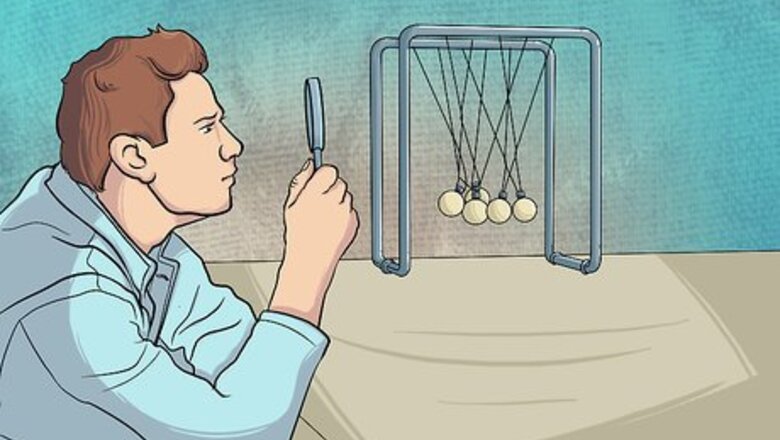
views
X
Research source
Evaluating the Damage

Determine where the tangles are located. You should do this in a well lit area, perhaps with a flashlight and magnifying glass handy. Figure out the number and location of the knots that have formed. See if you can follow which ball's string has gone around which other string or location on the cradle frame if that is the case. You might take this chance to manually tug on the knot to see if it will pry loose. If it only tightens, you need to stop and proceed with the alternatives.
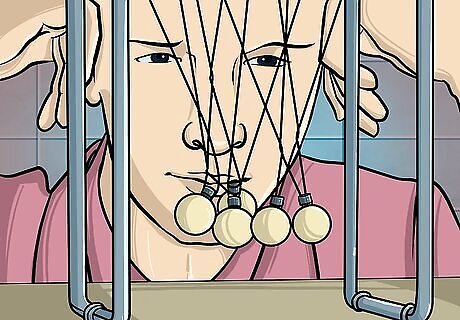
Examine what type of string or wire is being used. Either is possible, and if you are unsure which you have by visual inspection, you might check the packaging the cradle originally came with. If you are unsure what material the balls are suspended from the frame with, consider taking the cradle into a hardware store to have a professional look at it. String will be easier to handle regarding tools, but will be more delicate and likely to break. Wires will need better tools, but will be more durable while you work.
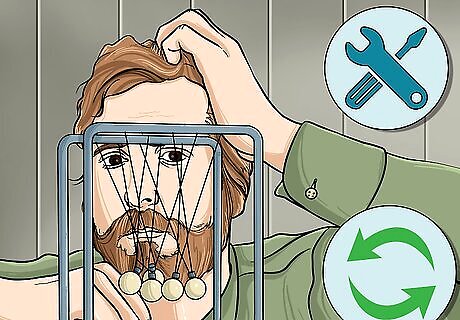
Consider if you want to repair or replace the affected parts. If you think the wires or strings are too badly damaged to simply untangle, you may have to replace them instead of just untangle them. If you damage the strings or wires during the untangling process, you may need to replace some of them anyway.
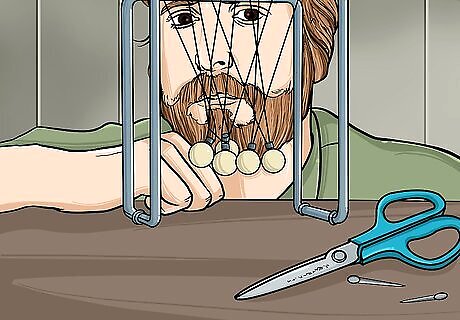
Identify what tools you may need. This will vary a bit depending on if you are dealing with string or wire. If you have a string-based cradle, a needle or pin may help with the prodding part of undoing the knot. A standard pair of scissors should suffice for cutting if it comes to that. If you are handling a wire-based cradle, you will need wire cutters

Establish if you should proceed with the repair or buy a new cradle. Desktop cradles are not usually expensive, so a replacement for the entire device may be a better option than a repair. If replacement string/wire is not readily available, a full device replacement is probably a better option. If you do not have the tools for undoing the knot or cutting the wire, getting a new cradle is a choice you should put more thought into. The repair itself can be a very painstaking, tedious process. So if you are unsure if you have the patience for the detail of the task, then a replacement cradle may be the way to go.
Untangling Your Newton’s Cradle
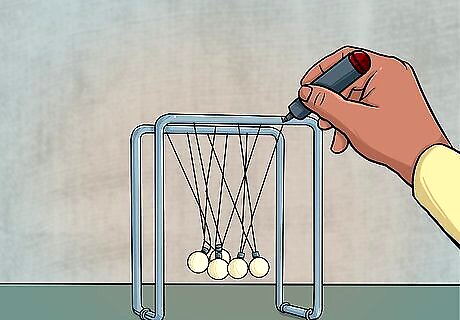
Prepare the cradle for the repair. Whether you untangle or cut the wires, you will need to do a few things to make sure the cradle is in working order when you are done. Mark or make a measurement note of where the wires are attached to the top bar. This is crucial to ensure the balls are suspended the correct distance apart again when you complete the repair. Measure how far the balls are supposed to be from the bar to the bottom of the frame. Make sure you have replacement strings or wires on hand. Make sure they are approximately the same thickness as the ones suspending the balls already if you have to do a swap-out. If you swap one, its best to swap out all of them to the same material or risk deviations in performance. Fishing wire or string will work. Whatever you choose, you will need to be able to cut and tie it if a swap occurs. Measure them so they are equal in length not only to each other, but to the length the original string/wires are.

Lean the cradle on one side. Set it so all of the balls are resting flat on the table. Make sure the balls are not rotating and getting even more tangled. You might find something heavy to brace the frame of the cradle with if keeping it stable is an issue. Keep a stationary lamp on to shine a light on your work.

Expose the knots. Use your hands at this point to maneuver the balls slowly and gently along the flat of the table so you can see the knots. Try to work the tangled balls in reverse around their respective tangles. Stop if the tension is tightening and not loosening. Any excessive force risks breaking the string/wire, so proceed cautiously.
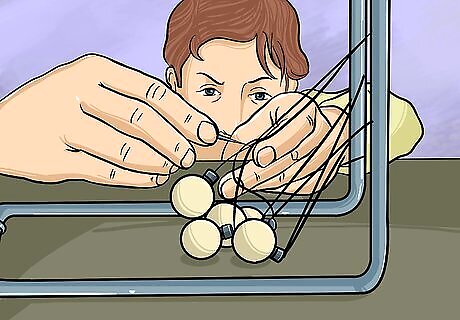
Loosen the knots with a pin. After you've exposed the knots, you can now proceed to prod them loose with your pin/needle. Do this one knot at a time. Insert the pin into the center cluster of the knot. Try not to insert the pin into the string/wire itself or you might fray it, and make working it unmanageable. Wiggle the pin in the center until the knot loosens and then withdraw the pin slowly. Repeat this with the other knots.

Pull the knots loose. The loose knots should give you a clearer view of where each string/wire leads to a ball. Find the last ball that went through the knot you are working on. Grasp a hold of the last ball and the string/wire that passes through the knot you are working on. Gently coax the wire and ball through the hole you opened up in the loosened knot cluster. If you notice things tightening up, you may have grabbed the wrong string and ball, so check again. Repeat this for the ball until it's free on its own string. Consider securing it with a zip tie or similar to the frame so it doesn't get tangled back up with the others. Repeat these steps again for each ball.
Cutting Your Newton's Cradle

See that untangling is not working. If the knots do not loosen, or you cannot undo them without breaking the wire, then cutting the string/wire may be an option. Only attempt this if you have extra string/wire handy to replace the ones you cut. You should replace all of the strings/wires with the same kind to avoid deviations in performance. You will need scissors for string or wire cutters for metal wires.

Cut above the tangle. Risk of injury is low, but thin wires, scissors, and wire cutters are potential hazards. So consider using gloves and eye protection. You will be retaining the balls and frame. Have a container ready to save the balls so they don't get lost. You will need to use your fingers to pull loose remaining string from the bar on the top of the frame. The balls will also have a peg that the string/wires are attached to. If you cannot pull the string/wire out of the peg or loop of the ball still, you may need to cut again closer to the ball to free it and then pull the remaining string/wire bits out by hand.
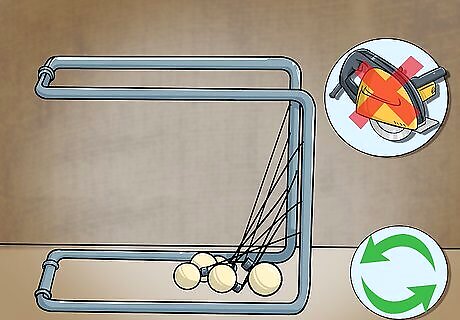
Disassemble the frame. Frame construction varies greatly, so if there are instructions that came with your cradle regarding assembly, you may want to consult them. Find a way to remove the frame sides and bar from each other. If they are one piece, this would require significantly more powerful metal cutting and reassembly tools and is not recommended--in the latter event you should reconsider replacing the entire device. Once the frame is disassembled, collect the bar and new strings/wires you prepared earlier.

Ensure your wires/string are the right length. You need to make sure the are the right length for the balls to fit the frame, but you also have enough to work with for fastening to the frame bar. Retrieve your measurement of the balls' necessary distance from the bar to the bottom of the frame. Prepare each string/wire so it's triple this length so you have enough for tying and adjusting. Use a tape measure to acquire the measurement. Use scissors on the strings, wire cutters on the wires to achieve the desired length.

Fasten the strings/wires to the balls first. Thread them through the hole or notch in the top of the bead and tie them together. If you can set up a stationary magnifying glass, it may help see your work better. You should have plenty of extra slack on the string/wire length to not have to redo a bad knot, but if you do--cutting and replacing the string is better than trying to undo the knot at this point. Repeat this for each ball.
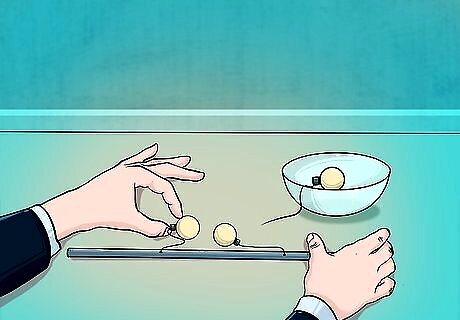
Attach the stringed/wired balls to the frame bar. Lay the bar flat on a table for this so measurements can be taken. Note the marks or measurements where the original strings/wires were attached. Try to re-fasten or re-tie the new strings/wires of each ball to the bar in the original places. Take advantage of the extra string/wire slack to adjust the distance of the ball to the bar so it matches the original distance measurement from the frame. Compare the new strings/wires of each ball to see if their distance from the bar is the same. If not, adjust it so it is before you do a final tie-off or fastening.
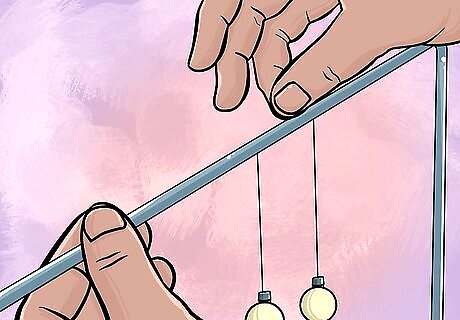
Restore the bar to the frame. Again, so the balls don't re-tangle themselves, it's best to do this while the bar is still lying mostly flat on a table. Find something to brace the balls with if necessary. Place the frame pieces around the bar in the configuration it originally came in. Reinsert the bar slowly, careful not to jar the balls in the process. Stand the device upright slowly while holding the balls in their line and let them down gently.

Assess your work. If the balls are visually not in alignment, you will have to disassemble the bar and frame and repeat the string/wire measurement process. If this happens, you should have enough excess string/wire leftover to just cut a little and readjust. Otherwise, you will have to completely replace the string/wire on the problem-ball(s). If you are unsure if the alignment is proper, use a ruler or tape measure to calculate each ball's vertical distance from the bar/frame and see if they match up. If not, you will have to readjust.

















Comments
0 comment